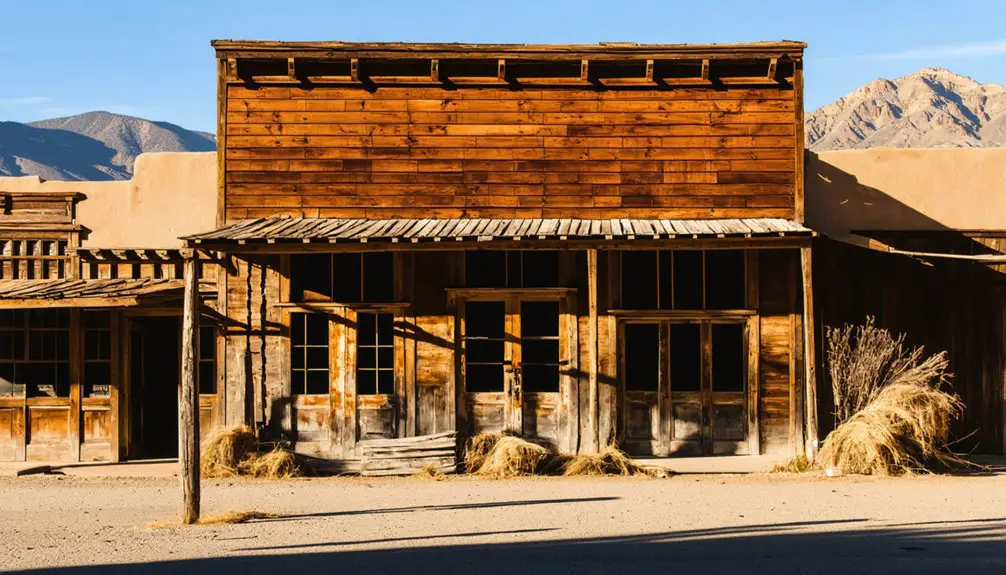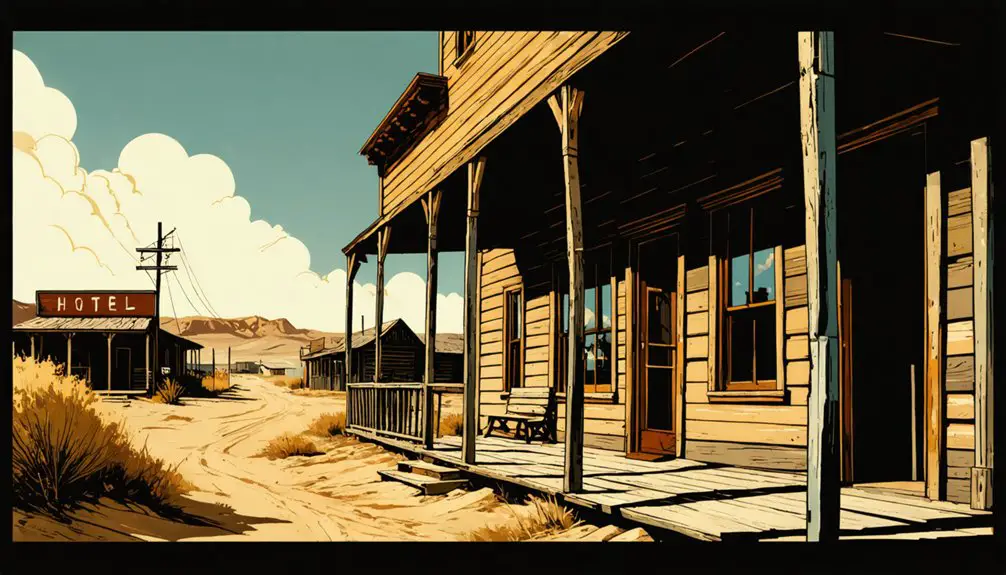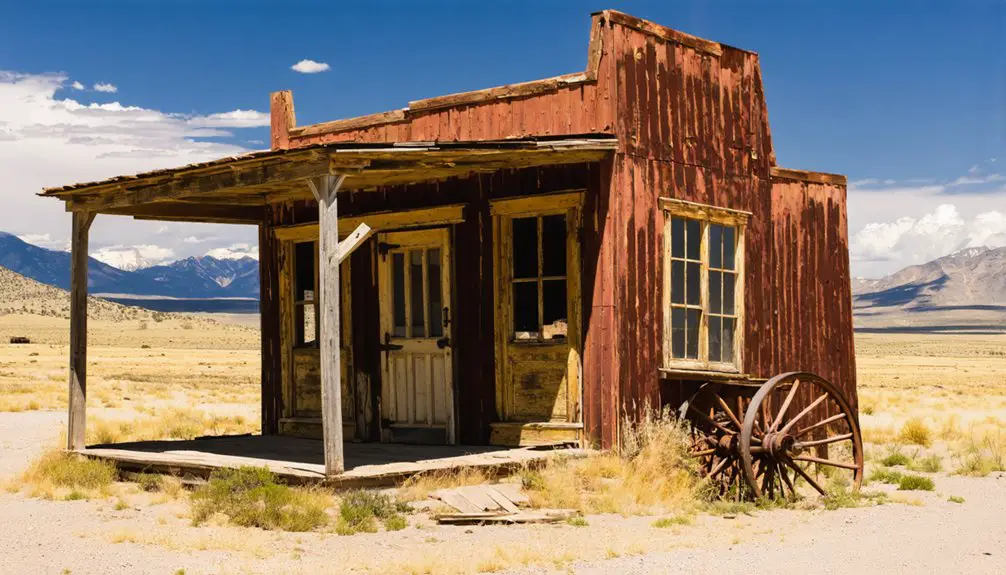You’ll discover Cimarron, New Mexico as a haunting symbol of the Wild West, established in 1859 along the Mountain Branch of the Santa Fe Trail. The town’s infamous St. James Hotel witnessed at least 26 murders, with outlaws like Jesse James and Billy the Kid frequenting its bullet-riddled halls. While no longer the bustling frontier settlement it once was, Cimarron’s violent past lives on through paranormal activities and historic landmarks that reveal a darker chapter of American history.
Key Takeaways
- Cimarron is not a ghost town but a living community that experienced significant decline after the Santa Fe Railway bypassed it.
- Founded in 1859, Cimarron was once a bustling frontier settlement centered around the Maxwell mansion and Aztec Mill.
- The town’s historic St. James Hotel, known for 26 murders and paranormal activity, remains a major tourist attraction today.
- Cimarron’s population decreased after the Santa Fe Trail route was abandoned in 1868 and the county seat moved to Springer.
- The town maintains its Western heritage through preserved buildings, haunted locations, and outdoor recreational activities for visitors.
The Origins of a Wild West Boomtown
While many frontier settlements emerged organically, Cimarron’s origins can be traced to a specific land grant filed in 1841 by Beaubien and Miranda, encompassing a vast 1.7 million acres that would later become the Maxwell Land Grant. To ensure accurate historical information, distinct articles exist about different Cimarron locations in various databases.
The town’s story took shape when fur trapper Lucien B. Maxwell married Luz Beaubien and inherited the ranch, establishing his mansion there in 1858. Maxwell’s grand house became a renowned gathering place, featuring various entertainment rooms.
You’ll find Cimarron’s name itself reflects its untamed nature, derived from the Spanish word for “wild” or “unbroken mustang.”
The settlement’s strategic location on the Mountain Branch of the Old Santa Fe Trail made it an essential stopover for westward travelers, while its position as a hub for frontier enterprises attracted diverse ventures in ranching and mining, leading to its official charter in 1859.
Blood and Bullets at the St. James Hotel
You’ll encounter the blood-soaked legacy of the St. James Hotel, where at least 26 murders occurred and notorious figures like Jesse James and Clay Allison left their violent mark.
The hotel’s bullet-riddled ceiling and haunted Room 18, where T.J. Wright’s spirit allegedly lingers, stand as proof of the establishment’s deadly past. Originally established by Lincoln’s personal chef, Henry Lambert began the venture as a saloon before it evolved into the infamous hotel.
Famous gunslingers, lawmen, and outlaws transformed this frontier establishment into a legendary site of Western conflict, where the line between justice and lawlessness frequently blurred in deadly confrontations. The hotel’s strategic location along the Cimarron Route made it a natural gathering point for travelers and desperados alike.
Violent Saloon Shootout History
During the tumultuous frontier days of the 1870s, the St. James Hotel’s saloon became notorious for its violent legends and deadly encounters.
You’ll find evidence of these saloon shootouts in the bullet-riddled tin ceiling, which required reinforcement with two layers of wood to protect upstairs guests.
While some tales have been embellished over time, the hotel witnessed at least 26 murders during Cimarron’s lawless period.
Famous outlaws like Clay Allison, Jesse James, and Billy the Kid frequented the establishment, contributing to its dangerous reputation.
Buffalo Bill Cody’s presence left literal marks, with bullet holes still visible today.
The original saloon still displays 22 visible bullet holes in its historic ceiling as testament to its violent past.
A particularly violent incident occurred when Pancho Griego killed three soldiers over a gambling dispute in 1875.
Though not every reported shooting occurred inside – many bodies were brought to the saloon from elsewhere for identification – the St. James remained a central hub of frontier violence, attracting gunfighters and desperados throughout its wild history.
Haunted Hotel Paranormal Activities
The violent history of Cimarron’s St. James Hotel has spawned countless ghostly encounters since its 1872 establishment. With 26 documented murders and over 400 bullet holes discovered during renovations, you’ll find substantial evidence of the property’s dark past.
Chef Henri Lambert, who previously cooked for President Lincoln, opened the establishment first as a restaurant and saloon.
The most active paranormal hotspot remains Room 18, where former owner Thomas James Wright’s malevolent spirit dwells after his murder. During the Colfax County War, intense conflicts between settlers and landowners led to numerous deaths within these walls.
You’ll encounter unexplained phenomena throughout the building, from spectral sightings of Mary Elizabeth Henry’s benevolent presence to a mischievous poltergeist known for driving knives into floors.
Ghost hunters have documented electronic disturbances, cold spots, phantom cigar smoke, and mysterious vortices. The second floor proves especially active, with multiple spirits manifesting amid routine equipment malfunctions and unexplained knocking sounds that echo through the historic halls.
Famous Gunslinger Guest Stories
As America’s most notorious gunslingers traversed the Old West, the St. James Hotel in Cimarron became a legendary crossroads where outlaw encounters shaped frontier history.
You’ll find the shadows of Jesse James, who claimed Room 14 as his regular refuge, and witness the legacy of Clay Allison’s violent outbursts that left bullet holes in the dining room ceiling.
The hotel’s dark reputation grew through Cimarron legends like Davy Crockett’s grandson gunning down three Buffalo Soldiers in 1876, and Black Jack Ketchum’s infamous stays.
Even lawmen weren’t immune to the hotel’s pull – Wyatt and Morgan Earp, with their wives, rested here before their fateful journey to Tombstone.
The St. James recorded 26 murders, earning the grim local saying, “Lambert had another man for breakfast.” Originally built as a restaurant and saloon in the late 1800s, the establishment evolved into the notorious hotel under Henry Lambert’s ownership.
Lawmen, Outlaws, and Daily Life
Life in Cimarron during the late 1800s revolved around a volatile mix of lawmen, outlaws, and everyday citizens struggling to maintain order in this New Mexico boomtown.
Cimarron’s chaotic frontier days pitted determined lawmen against ruthless outlaws while townsfolk fought to preserve civility in their dusty streets.
You’d find sheriffs like Ed Farr employing aggressive lawmen tactics to pursue notorious figures like the Ketchum gang, while Special Agent W.H. Reno collaborated with local authorities to track train robbers.
The outlaw culture thrived through figures like Clay Allison and Davy Crockett, who terrorized the town with violent raids and murders. The Lamberts Inn became especially notorious as twenty-six men met their deaths inside its walls.
Daily life centered around saloons and dance halls, where settlers sought entertainment amid constant threats from corrupt land grant owners and the Santa Fe Ring.
You’d witness settlers facing economic hardship and eviction while corrupt territorial judges dismissed charges against violent landowners, creating a perpetual cycle of lawlessness and instability.
The Violent Saga of the Colfax County War

Violent disputes over the Maxwell Land Grant erupted into the Colfax County War in 1873, pitting settlers against powerful new English and Dutch landowners backed by the notorious Santa Fe Ring.
The Cimarron conflicts escalated when settlers armed themselves after a March meeting, defending lands they’d occupied for years.
Land disputes turned deadly with frequent shootouts, night raids, and property destruction. The murder of Reverend Tolby in 1875 and the killing of three Buffalo Soldiers at the St. James Hotel intensified the violence.
You’d have witnessed hired gunmen terrorizing resisters while the Maxwell Land Grant owners orchestrated brutal retaliation campaigns.
Despite Governor Giddings requesting military intervention, the arrival of the 9th Cavalry only fueled more bloodshed.
The war exposed the territory’s corrupt political underpinnings and the Santa Fe Ring’s iron grip on power.
Haunted Heritage and Paranormal Tales
You’ll encounter restless spirits throughout Cimarron’s historic St. James Hotel, where over 26 documented murders have left an indelible paranormal imprint on the property.
The hotel’s infamous Room 18, permanently sealed due to intense spectral activity, stands as evidence of T.J. Wright’s violent death and the countless other souls who met their end during the town’s lawless era.
Through countless investigations and eyewitness accounts, the paranormal legacy lives on through documented phenomena including spectral apparitions, unexplained sounds, and mysterious cold spots that continue to draw ghost hunters and curious visitors alike.
Restless Spirits Still Linger
Among the most haunted locations in New Mexico’s ghost towns, Cimarron’s St. James Hotel stands as a monument to the untamed spirit of the Old West.
You’ll find evidence of its violent past in the 22 bullet holes that still mark the dining room ceiling, while spectral sightings continue to draw paranormal investigators and curious visitors alike.
At 3 a.m., you might hear unexplained screams echoing through the halls, especially near Room 18, where T.J. Wright’s ghost reportedly lingers after his murder.
Ghostly encounters aren’t limited to a single space – throughout the hotel, you’ll discover rooms named after historical figures like Jesse James and Buffalo Bill Cody, each with its own supernatural tale.
Mary’s Room (#17) remains particularly active, with guests reporting aggressive paranormal activity that keeps even the bravest visitors on edge.
Violent Deaths Shape Legend
While the St. James Hotel stands as a symbol of Cimarron’s violent folklore, you’ll find its darkest legacy in the 26 confirmed murders that occurred within its walls.
The hotel’s haunted reputation stems from three primary sources:
- The brutal killing of Constable Cruz Vega by Clay Allison’s mob in 1875
- Francisco Griego’s death during a heated confrontation at Lambert’s Inn
- The numerous saloon shootings that claimed lives throughout the town’s peak
These violent deaths have fueled decades of reported ghostly encounters, with visitors claiming to witness apparitions of gunslingers, murdered lawmen, and victims of frontier justice.
Beyond the hotel, Cimarron’s transformation into a ghost town directly correlates with its bloody past, as residents fled the constant threat of violence that defined this once-thriving frontier settlement.
Hotel’s Haunted Room Legacy
The St. James Hotel’s haunted history centers on two notorious second-floor rooms that you’ll find steeped in paranormal activity.
In Room 18, you’ll encounter the angry spirit of Thomas James Wright, who was murdered after a poker game. The room remains perpetually locked, containing only sparse furnishings and reports of an eerie orange orb.
Next door, Room 17 harbors Mary Elizabeth’s protective presence, marked by the distinct scent of rose perfume and gentle tapping sounds.
Throughout the hotel’s 43 rooms, you’ll witness evidence of its violent past, including bullet-riddled ceilings and locations of 26 documented murders.
The ghostly encounters range from unexplained cigar smoke to a mysterious cowboy’s reflection in the bar mirror, making the St. James a premier destination for those seeking authentic paranormal experiences.
Historic Architecture and Landmarks
Cimarron’s architectural heritage spans over four millennia, showcasing structures from prehistoric indigenous pit houses to Victorian-era landmarks that define today’s ghost town landscape.
The U.S. Forest Service’s historic preservation efforts protect key structures that reflect the region’s diverse architectural styles and cultural evolution.
Federal preservation initiatives safeguard Cimarron’s historic buildings, ensuring these cultural landmarks endure as living testaments to our architectural heritage.
You’ll find significant landmarks that capture Cimarron’s frontier spirit:
- The three-story Old Aztec Grist Mill (1864), now operating as a museum with working mill components
- The Victorian-styled St. James Hotel, restored in 1985 while maintaining its authentic character
- Ancient indigenous stone constructions along Forest Road 1950, featuring hunting blinds and petroglyphs
Today’s Cimarron stands as a reflection of multiple eras, from its Native American roots through the mining boom and into the post-World War II decline, with each period leaving its distinct architectural mark.
Notable Characters and Famous Visitors

Legendary figures from America’s frontier era left an indelible mark on Cimarron’s historical landscape, transforming this New Mexico settlement into a crossroads of fame and infamy.
You’ll find cultural influences spanning from lawmen like Fred Lambert, trained by Buffalo Bill Cody himself, to notorious outlaws including Clay Allison and Billy the Kid.
The St. James Hotel served as a nexus for historical connections, hosting renowned figures such as Wyatt Earp, Bat Masterson, and even Governor Lew Wallace, author of “Ben-Hur.”
Artists and writers also found inspiration here, with Frederic Remington’s Western art and Zane Grey’s novels drawing from Cimarron’s frontier spirit.
The town’s entertainment legacy flourished through Buffalo Bill and Annie Oakley’s performances, which featured local Native Americans in their touring shows.
From Frontier Fortune to Economic Decline
While situated within the sprawling 1.7 million-acre Maxwell Land Grant, Cimarron emerged in 1859 as a bustling frontier settlement centered around Lucien B. Maxwell’s mansion and the essential Aztec Mill.
The town’s strategic location along the Mountain Branch of the Santa Fe Trail fueled its early prosperity through trade, ranching, and resource exploitation.
Three major economic shifts sealed Cimarron’s fate:
- The Santa Fe Railway’s decision to bypass the town
- The relocation of the county seat to Springer in 1881
- The abandonment of the Santa Fe Trail route by 1868
You’ll find that violent land grant disputes and the infamous Colfax County War further destabilized the local economy, ultimately driving residents away.
As political importance waned and commercial opportunities diminished, Cimarron’s transformation into a ghost town became inevitable.
Modern Day Tourism and Ghost Town Appeal
Despite its economic decline in earlier decades, modern-day Cimarron has reinvented itself as a compelling tourist destination that capitalizes on its haunted history and outdoor recreation opportunities.
You’ll find ghost tourism centered around the legendary St. James Hotel, where 26 murders and numerous paranormal encounters draw visitors seeking supernatural thrills. The hotel’s Room 18, permanently sealed due to reported hauntings, exemplifies the town’s mysterious allure.
Community engagement flourishes through five museums, including the Old Mill Museum, which provide educational context beyond ghost hunting.
You can explore hiking trails, cast a line in prime fly-fishing spots, or join guided ghost hunts. While the pandemic temporarily affected tourism, Cimarron’s blend of haunted attractions, outdoor activities, and historical education continues to draw visitors year-round.
Frequently Asked Questions
What Is the Current Cost of Staying Overnight at the St. James Hotel?
You’ll pay between $115-$260 per night at this historic hotel, with rates varying based on choosing either traditional Cimarron history rooms or modern annex rooms with updated amenities.
Are There Any Active Mining Claims Still Operating Near Cimarron?
You won’t find any active claims operating near the area today. While the region has a rich mining history, the former Superfund site is now limited to commercial reuse and environmental monitoring.
What Restaurants and Dining Options Exist in Modern-Day Cimarron?
You’ll find historic dining at Saint James Hotel, Lambert’s, and Cimarron Mercantile, plus local eateries like Burrito Banquet and Colfax Tavern. These spots blend dining history with modern takeout options.
How Far Is Cimarron From the Nearest Major Airport?
Like a traveler seeking wings of freedom, you’ll find your closest air gateway at Durango-La Plata County Airport, just 55 miles northwest, while major airport options stretch 135-140 miles to Albuquerque.
What Are the Local Weather Patterns and Best Seasons to Visit?
You’ll find significant seasonal trends with summer highs near 80°F and winter lows around 9°F. Visit during late spring or early fall for ideal weather variations and fewer precipitation challenges.
References
- https://elchuqueno.com/city-of-dust-the-st-james-hotel-cimarron-new-mexico/
- https://www.legendsofamerica.com/nm-cimarron/
- https://www.newmexicomagazine.org/blog/post/travel-northeastern-new-mexico-cimarron/
- https://www.youtube.com/watch?v=C7VG-VXda7Y
- https://www.ghosttowngallery.com/htme/cimarron.htm
- https://truewestmagazine.com/article/what-can-you-tell-me-about-cimarron-new-mexico-2/
- https://en.wikipedia.org/wiki/Cimarron
- https://theroadslowlytraveled.com/cimarron-canyon-state-park-and-the-once-wild-town-of-cimarron/
- https://nomadicniko.com/2015/10/30/cimarron/
- https://en.wikipedia.org/wiki/St._James_Hotel_(Cimarron



